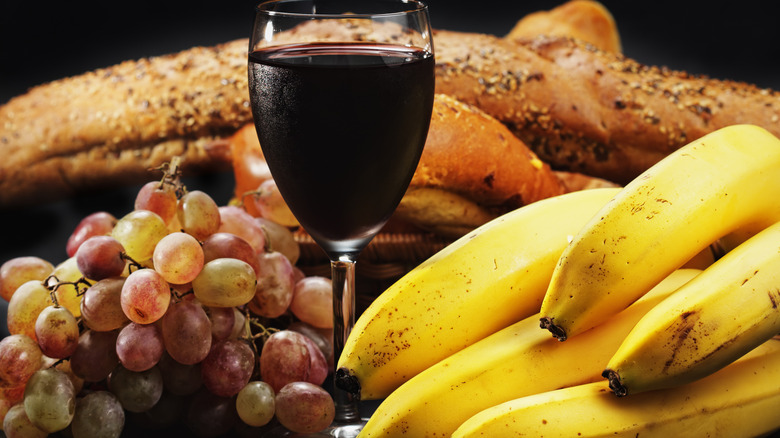Believe It Or Not, You Can Actually Make Wine Out Of Bananas
The word "wine" is ubiquitous with grapes; most commercial wines are made with grape juice of some kind. In fact, almost all of the wines we drink are made from a specific genus of grapevines known as Vitis vinifera, according to Wine Spectator. But winemaking is not limited to only Pinot Noir and Cabernet. The basic process for making wine is simply fermenting sweet juice, and there's no rule that it can only come from grapes.
There are actually thousands of delicious wines you can buy made from other fruits — and sometimes even vegetables and flowers — including bananas. You can also make a fruit wine at home if you have a favorite flavor; all you need is a basic recipe and some simple equipment.
It wasn't until the times of the ancient Roman Empire that people realized grapes made pretty good wine, thanks to their natural balance of sugar and acid. But fruit wines have been around a lot longer. Ancient Mesopotamians were drinking fig, date, and watermelon wines around 50,000 years ago, according to The Tipsy Grape. Those historical wines would probably be undrinkable by today's standards, but it bodes well for banana lovers to know that the world's first wines were made with tropical fruits.
How to make homemade wine
Americans eat quite a few bananas — around 28 pounds of them per year, according to Statista. And while a lot of them are eaten raw, baked into banana bread recipes, or dipped in chocolate and frozen, that still leaves a lot of room for more imaginative means. Perhaps one of the most creative ways to use bananas is in making wine.
Banana wine is made commercially in parts of the world where the starchy fruits grow naturally. You can even find the tropical sipper at a few wineries in the United States, including some in Florida. But it's not so hard to make a batch of banana wine at home if you can't get your hands on some, and the internet is full of recipes and step-by-step instructions.
Because bananas are available at the grocery store year-round, you can try making a one-gallon batch of banana wine, which makes about five bottles of finished wine (per Wine Folly). You'll only need a few basic pieces of home winemaking equipment, including a fermenter, a hydrometer (which measures the sugar in your juice and wine), and a few other items. (They're often sold together in a beginner's winemaking kit, such as this one from Midwest Supplies.) If you make home-brewed beer, you probably already have a lot of the things you need.
A tropical tipple
The tricky part of making banana wine is balancing out the acid, sugar, and structure to create a beverage you'll actually enjoy drinking. WineMaker explains that most wines made with tropical fruits can be thin-bodied if you don't tinker a little bit with the juice, which is called "must" in winemaking. The thin body occurs because there's a lot of sugar and starch in bananas, which will mostly turn into alcohol when you ferment it.
Lots of recipes recommend recommend adding some dried raisins to the mix (per Northeast Winemaking), plus some other winemaking ingredients, including pectic acid (to break down the pectins in the fruit) and acid blend powder.
Once you have all your equipment and ingredients, make your banana juice by mashing up the fruit and adding it to water. Once everything is combined, add the yeast to the must and let it work its magic. It takes the yeast about seven days to ferment the first stage your wine, which is called primary fermentation. Then, you'll move the wine from one container to another to remove the dead yeast cells, which is called racking, and then let the wine continue to develop for about 14 days, which is called secondary fermentation. After this point, you can try your wine to see if it tastes good or if you need to adjust it for sweetness, body, or structure. Then, it's ready to be bottled.


